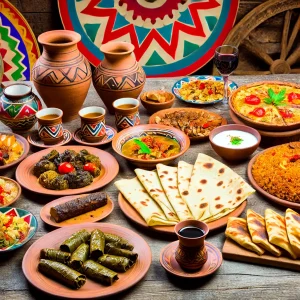Armenian culture is a vibrant and rich tapestry that has evolved over millennia. Influenced by its geography, historical events, and interactions with neighboring civilizations, Armenia boasts a unique cultural heritage that encompasses everything from art and architecture to music and culinary traditions. This page delves into the various aspects of Armenian culture, offering an in-depth look at the elements that make it so distinctive and enduring.
Historical Context of Armenian Culture
The roots of Armenian culture can be traced back over 4,000 years, with the earliest influences coming from the Urartian civilization. Over the centuries, Armenia’s strategic position at the crossroads of Europe and Asia has made it a melting pot of various cultures. This rich historical backdrop has given rise to a unique cultural identity that is deeply intertwined with the nation’s history.
Armenian Language and Literature
The Armenian language, with its unique script developed by Mesrop Mashtots in the early 5th century, is a cornerstone of Armenian identity. Armenian literature boasts a rich tradition of both oral and written works, ranging from ancient epic poems to contemporary novels. Key literary figures include the medieval historian Movses Khorenatsi and the modern poet Hovhannes Shiraz.
Armenian Art and Architecture
Armenian art and architecture are renowned for their distinctive styles and intricate details.
Miniature Painting
Armenian miniature painting, often found in illuminated manuscripts, is characterized by its vibrant colors and detailed imagery. These works of art not only serve as religious texts but also as visual records of Armenian history and culture.
Khachkars
Khachkars, or stone crosses, are a unique form of Armenian sculpture. These intricately carved stones serve as both religious monuments and works of art, often commemorating significant events or individuals.
Church Architecture
Armenian churches are notable for their unique architectural styles, featuring pointed domes, cross-shaped layouts, and detailed stone carvings. Iconic examples include the Etchmiadzin Cathedral, the spiritual center of the Armenian Apostolic Church, and the rock-carved Geghard Monastery.
Armenian Cross
The Armenian Cross is a profound symbol of the nation’s Christian faith and cultural identity. Characterized by its unique flared arms and intricate patterns, the Armenian Cross symbolizes Christ’s sacrifice, resurrection, and eternal life. It is often adorned with detailed carvings and motifs, making it both a religious symbol and a piece of art. The cross plays a central role in Armenian religious practices and is commonly found in churches, khachkars, and religious jewelry.

Music and Dance
Armenian music is an integral part of the nation’s cultural heritage, blending traditional folk tunes with contemporary compositions.
Folk Music
Traditional Armenian folk music often features instruments like the duduk, a woodwind instrument with a hauntingly beautiful sound, and the kanun, a type of zither. Folk songs typically reflect themes of love, nature, and historical events.
Dance
Armenian dance is characterized by its energetic movements and intricate footwork. Traditional dances, such as the Kochari and Shalakho, are performed at celebrations and cultural festivals, showcasing the community’s spirit and joy.
Cuisine

Armenian cuisine is a delightful blend of flavors and ingredients, reflecting the country’s agricultural heritage and culinary influences from neighboring regions.
Staple Dishes
- Lavash: Traditional Armenian flatbread, often baked in a tonir (a type of clay oven).
- Khorovats: Armenian BBQ, typically featuring marinated meats grilled to perfection.
- Dolma: Grape leaves stuffed with a mixture of rice, meat, and spices.
- Harissa: A hearty porridge made from wheat and meat, often enjoyed during religious holidays.
Beverages
- Armenian Coffee: Rich and flavorful, Armenian coffee is a beloved tradition, often enjoyed with friends and family.
- Tan: A refreshing yogurt-based drink, similar to buttermilk, often consumed with meals.
Armenian Festivals and Traditions
Armenian culture is marked by a variety of festivals and traditions that celebrate the nation’s history, religion, and community spirit.
Vardavar
An ancient festival with pagan roots, Vardavar involves splashing water on each other and celebrates the transfiguration of Christ. It’s a joyful event that brings communities together in celebration.
Genocide Remembrance Day
Observed on April 24th, this solemn day commemorates the victims of the Armenian Genocide. It’s a time for reflection, remembrance, and honoring the resilience of the Armenian people.
Weddings
Armenian weddings are vibrant celebrations filled with music, dance, and traditional rituals. The ceremony often includes the blessing of the rings, crowning of the couple, and an elaborate reception with plenty of food and dancing.
Religion in Armenian Culture
Christianity has played a central role in shaping Armenian culture. Armenia was the first nation to adopt Christianity as its state religion in 301 AD, and the Armenian Apostolic Church has been a cornerstone of Armenian identity ever since.
Armenian Apostolic Church

The church’s traditions, rituals, and liturgical music are integral parts of Armenian religious life. Major religious sites, such as the Etchmiadzin Cathedral, serve as both spiritual centers and symbols of the nation’s faith.
Religious Festivals
Armenian religious festivals, such as Easter and Christmas, are celebrated with unique customs and rituals, often involving special church services, communal meals, and family gatherings.
Armenian culture is a rich and multifaceted tapestry that reflects the nation’s long history, artistic achievements, and enduring traditions. From the intricate designs of khachkars and the haunting melodies of the duduk to the vibrant celebrations of festivals and the deep faith expressed through religious practices, Armenian culture continues to thrive and inspire. By exploring these elements, one gains a deeper appreciation for the resilience, creativity, and spirit of the Armenian people.




